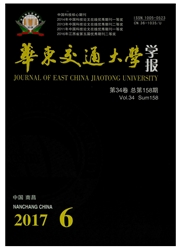

 中文摘要:
中文摘要:
为提高MMC-RPC的抗扰动性能并达到更为精确的控制效果,对采用模块化多电平换流器(MMC)的铁路功率调节器(RPC)建立了动态数学模型,在简要介绍微分平坦控制理论(FBC)的基础上于MMC-RPC的动态数学模型中选取了2组输出量,使MMC-RPC满足微分平坦系统的条件。由微分平坦理论设计了MMC-RPC的控制器,其结构包含前馈控制与误差补偿2个环节;控制器采用串级连接,由外环产生平坦输出的参考轨迹,内环产生MMC期望输出的d、q轴电压分量。最后在3种工况下分别对串级FBC控制的MMC-RPC与串级PI控制的MMC-RPC进行仿真,仿真结果验证了FBC控制系统的有效性与优越性。
 英文摘要:
英文摘要:
In order to improve the anti-disturbance performance and achieve more accurate control effect of MMC-RPC, a dynamic mathematical model was established for the railway static power conditioner (RPC) by using the modular multilevel converter (MMC) structure. Based on the introduction of differential flatness control theory (FBC), two set of outputs were selected from the dynamic mathematical model of MMC-RPC, which enabled MMC-RPC to meet the conditions of the differential flatness system. The structure of the FBC controller had two parts, i.e. feed forward control and error compensation respectively, with cascade connection. The outer loop generated a flat output which was the reference trajectory, and the inner loop generated the d and q axis voltage components which were the expected output of MMC. The simulation result of the MMC-RPC system which was controlled by FBC and Pl in 3 working conditions verified the validity and superiority of the FBC control system.
 同期刊论文项目
同期刊论文项目
 同项目期刊论文
同项目期刊论文
 期刊信息
期刊信息
